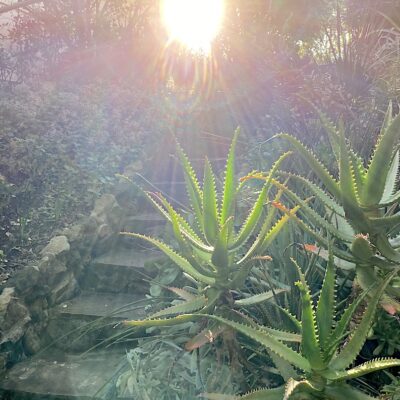These six late-summer care essentials for succulents come from my own experience with growing hundreds of varieties over decades. In my inland Southern CA garden, late summer heat can do as much damage as midwinter frosts. Below is what I do routinely every year. Modify my suggestions according to your own climate and region.
1. Shade any smooth-leaved succulents that are not from the desert Southwest
Unless you live in a mild, maritime location, those that I call "the pretty little ones" need protection from scorching summer sun. Ideally they'll get several hours of early morning or late afternoon sun, and bright or dappled shade the rest of the day. (See how I define Types of Shade.) If need be, throw a sheet or shade cloth over exposed aeoniums, aloes, echeverias, kalanchoes, and the like.
2. Protect young desert plants
When established, most cacti, yuccas, agaves and other succulents native to Mexico and the Southwest sail through summer. However even in their native habitats, young cacti grow beneath "nurse plants" that shelter them from harsh conditions.

Above: View from my deck during a mid-August heat wave that sent temps into the triple digits. I'm located midway between ocean and desert. When temps rise into the 90s in late summer, thunderheads appear in the eastern sky. Occasionally the storms drift this way and we see flashes of lightning and may even get rain.
3. Give cold-climate succulents preferential treatment
Rock-garden plants such as sempervivums (hens-and-chicks) and sedums (stonecrops) thrive in the northern and eastern US and in Europe. Farther south, these can go downhill when temperatures rise above 80 degrees F. Keep them shaded and cool. Exceptions are sedums (and Sedum crosses such as graptosedums) that have fat, thumb-sized leaves and that turn vivid shades of red and orange.
4. Monitor soil moisture
Soil that goes bone dry may not kill thick-leaved and -trunked succulents, but if fine root filaments desiccate, growth will slow or cease. In pots you can test soil moisture by inserting a chopstick; if soil clings, it's moist.
5. Soak plants before leaving town
Generally if other conditions are met, succulents won't miss you if you water them well before you leave, then again when you return. As an extra precaution in case temperatures rise significantly while you're gone, move potted succulents into shade.
6. Don't stress over your succulents
Gardening is a process, and sometimes the only way to know what will do well is to lose a few plants. Weather extremes lead to valuable lessons. Consider any casualties as annuals, and fill gaps when weather cools.
Related info on this site
Summer Care for Succulents: Heat and Sun Concerns
Don’t let summer sun and heat harm your succulents! Heat generally isn’t a concern. Although some succulents (like sempervivums) tend not to thrive in temps above 80 or 90 degrees F, the majority are fine. It’s heat plus sun that’s the concern.
Don’t Let a Heat Wave Ruin Your Succulents
You have two options for protecting your succulents from heat waves that follow cool weather:
1. Move them. Of course this is only possible if they’re in pots. But don’t forget to do it! When sudden heat and sun hit, succulents that haven’t had time to acclimate may sunburn. There’s no reversing the resulting brown or beige patches.
Agaves Handle Summer Heat
Late summer is when tough succulents really shine. Large agaves handle summer heat, and are unfazed by harsh sun, high temps and lack of rain. Their statuesque, fountainlike forms lend a sculptural element to any landscape, and contrast beautifully with fine-textured ornamentals. They also make good firebreak plants and security fences. With the exception of a few…
The post Late Summer Succulent Care: Six Essentials appeared first on Debra Lee Baldwin. Copyright © Debra Lee Baldwin.
from Debra Lee Baldwin https://ift.tt/2Y5mW5K
via IFTTT




No hay comentarios:
Publicar un comentario